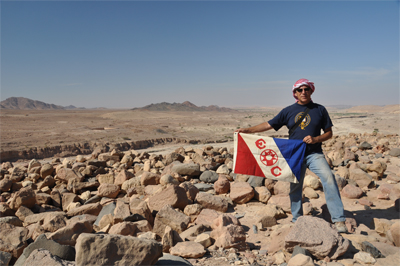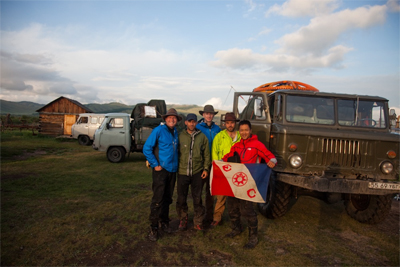UC San Diego Researchers Receive Explorers Club Awards
San Diego, October 20, 2011 -- The venerable Explorers Club handed out its annual Lowell Thomas Awards this week in St. Louis to celebrate some of the country’s most remarkable explorers, and two of the six awards went to researchers from a technology institute at the University of California, San Diego.
|
Lin was on hand to accept his award, while Levy recorded his remarks from the field, where he is leading a new expedition and living in a remote tent camp without electricity in southern Jordan.
“We are searching for the political and economic center of Iron Age copper production some 3,000 years ago in the southeastern Mediterranean basin,” said Levy. “We are using state-of-the-art cyber-archaeology to help revolutionize our understanding of the relationship between archaeology and ancient Near Eastern texts – specifically, the Old Testament or Hebrew Bible.”
Fellow UCSD researcher Albert Lin was cited for his exploration of the Mongolian steppe in search of uncharted heritage sites, notably the lost tomb of Genghis Khan. Accepting his award, Lin talked about his four-year effort to do so without digging in the ground. Instead, his team used non-invasive technologies, including satellite imaging, ground-penetrating radar, and unmanned aerial vehicles, as well as crowdsourcing to engage the public in the search via a National Geographic web portal running applications developed at UCSD.
“It was amazing to be there with the other awardees, especially after seeing the list of previous winners, like Carl Sagan, Neil Armstrong, Chuck Yaeger, Jacques Cousteau and other icons of 20th century exploration,” recalled Lin after the event. “It was clear from other awardees and fellow Explorers Club members that exploration in the name of understanding the world around us continues to thrive, with even more purpose than before, given the urgency of taking what we learn and applying it to conservation.”
|
An hour-long TV documentary on the project, “The Forbidden Tomb of Genghis Khan”, will premiere on the National Geographic Channel on Wednesday, Nov. 9 at 9PM ET. Much of the broadcast was filmed in July and August 2010, when Lin led his second UCSD-National Geographic expedition to Mongolia. During the same expedition, Lin carried a time-honored artifact for American explorers since 1918: an official Explorers Club Flag, #99.
Then this October his CISA3 colleague, Tom Levy, carried a similar flag, #117, into the Jordanian desert. Levy has been a member of the Explorers Club since 2009. Flags are reserved for major expeditions that must “further the cause of exploration and field science.” Today there are 202 numbered flags, each with its own history of specific expeditions. Flags are returned to the Club with a written record of the expedition, called the ‘Flag Report’.
The theme of the awards dinner on Oct. 15 in St. Louis was “Exploring the World’s Greatest Mysteries,” and Levy argues that one such mystery is the relationship between ancient sacred texts and archaeology. Example: Many scholars dismissed Biblical accounts of David and Solomon as pure myth because there was no evidence that complex societies such as kingdoms existed in the Holy Land during the 10th century BC. “Our work demonstrates that industrial-scale copper production took place in the 10th century BC and that those activities could only have been organized by a complex society such as a kingdom – the type of society alluded to in the Bible for this period,” Levy told the audience on video. “While we have not proven that David or Solomon controlled copper production in Faynan, known as Edom in the Bible, we have shown that complex societies did exist during this period – a picture reflected in the Old Testament.”
Levy also told his fellow members of the Explorers Club that technology is critical to the future of archaeology. “While digging with trowels and brushes are central to our field work, our new digital archaeology ‘toolbox’ includes a wealth of new technologies,” said Levy. “LiDAR laser scanning enables us to collect billions of geo-referenced data points with sub-centimeter accuracy. X-ray fluorescence and other handheld devices can characterize the elemental makeup of artifacts, and technologies such as Global Positioning Systems, Reflectorless Total Stations, and low-altitude, helium balloon-based 3D digital photography all provide data that can be organized in a Geographic Information System, or GIS. This Flag Expedition is probably the most advanced to date in terms of bringing cyber-archaeology into the field.”
Levy’s previous expeditions in southern Jordan have been documented in National Geographic magazine, and in a TV documentary produced by National Geographic and NOVA. “Quest for Solomon’s Mines” premiered in November 2010 on PBS stations around the country.
In addition to Levy and Lin, four other 2011 Lowell Thomas Awards went to: field biologist Brent S. Stewart, a senior research scientist at the Hubbs-SeaWorld Research Institute, who studies the ocean migration of the world’s largest fish; William C. Stone, one of the world’s foremost expeditionary cavers and CEO of Stone Aerospace; paleohydrologists Kenneth and Ruth Wright, best known for their research on the water-supply system of the Incan settlement at Machu Picchu in modern-day Peru; and three Chilean experts – Edmundo Edwards, Patricia Vargas Casanova, and Claudio Cristino – who shared an award for their work on Easter Island and the culture of Eastern Polynesia.
Related Links
Explorers Club
Explorers Club Science Symposium
National Geographic Society
Albert Yu-Min Lin, Ph.D.
Thomas E. Levy, Ph.D.
CISA3
IGERT-TEECH
Media Contacts
Doug Ramsey, 858-822-5825, dramsey@ucsd.edu



